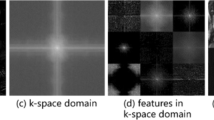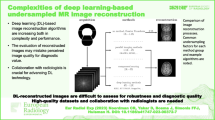Abstract
Accurate reconstruction of accelerated Magnetic Resonance Imaging (MRI) would produce myriad clinical benefits including higher patient throughput and lower examination cost. Traditional approaches utilize statistical methods in the frequency domain combined with Inverse Discrete Fourier Transform (IDFT) to interpolate the under-sampled frequency domain (referred as k-space) and often result in large artifacts in spatial domain. Recent advances in deep learning-based methods for MRI reconstruction, albeit outperforming traditional methods, fail to incorporate raw coil data and spatial domain data in an end-to-end manner. In this paper, we introduce a cross-domain fusion network (CDF-Net), a neural network architecture that recreates high resolution MRI reconstructions from an under-sampled single-coil k-space by taking advantage of relationships in both the frequency and spatial domains while also having an awareness of which frequencies have been omitted. CDF-Net consists of three main components, a U-Net variant operating on the spatial domain, another U-Net performing inpainting in k-space, and a ‘frequency informed’ U-Net variant merging the two reconstructions as well as a skip connected zero-filled reconstruction. The proposed CDF-Net represents one of the first end-to-end MRI reconstruction network that leverages relationships in both k-space and the spatial domain with a novel ‘frequency information pathway’ that allows information about missing frequencies to flow into the spatial domain. Trained on the largest public fastMRI dataset, CDF-Net outperforms both traditional statistical interpolation and deep learning-based methods by a large margin.
Access this chapter
Tax calculation will be finalised at checkout
Purchases are for personal use only
Similar content being viewed by others
Notes
- 1.
The original KIKI-Net is not open-source and the paper does not offer a full description of its CNN architectures. We do our best to recreate it and modify it such that comparisons are fair.
References
Zhu, B., Liu, J.Z., Cauley, S.F., Rosen, B.R.: Image reconstruction by domain transform manifold learning. Nature 555(7697), 487 (2018)
Hennig, J., Nauerth, A., Friedburg, H.: Rare imaging: a fast imaging method for clinical MR. Magn. Reson. Med. 3(6), 823–833 (1986)
Oppelt, A., Graumann, R., Barfuss, H., Fischer, H., Hartl, W., Schajor, W.: FISP - a new fast MRI sequence. Electromedica 54(1), 15–18 (1986)
Moratal, D., Valles-Luch, A., Marti-Bonmati, L., Brummer, M.E.: k-space tutorial: an MRI educational tool for a better understanding of k-space. Biomed. Imaging Interv. J. 4(1) (2008)
Knoll, F., et al.: Deep learning methods for parallel magnetic resonance image reconstruction. Preprint arXiv:1904 (2019)
Klatzer, T., et al.: Learning a variational network for reconstruction of accelerated MRI data. Magn. Reson. Med. 79, 3055–3071 (2018)
Aggarwal, H.K., Mani, M.P., Jacob, M.: MoDL: model-based deep learning architecture for inverse problems. IEEE Trans. Med. Imaging 38(2), 394–405 (2018)
Zhang, P., Wang, F., Xu, W., Li, Yu.: Multi-channel generative adversarial network for parallel magnetic resonance image reconstruction in K-space. In: Frangi, A.F., Schnabel, J.A., Davatzikos, C., Alberola-López, C., Fichtinger, G. (eds.) MICCAI 2018. LNCS, vol. 11070, pp. 180–188. Springer, Cham (2018). https://doi.org/10.1007/978-3-030-00928-1_21
Huang, Q., Yang, D., Wu, P., Qu, H., Yi, J., Metaxas, D.: MRI reconstruction via cascaded channel-wise attention network. In: 2019 IEEE 16th International Symposium on Biomedical Imaging, pp. 1622–1626 (2019)
Lønning, K., Putzky, P., Caan, M.W.A., Welling, M.: A deep cascade of convolutional neural networks for dynamic MR image reconstruction. Int. Soc. Magn. Reson. Med. (2018)
Schlemper, J., Caballero, J., Hajnal, J.V., Price, A.N., Rueckert, D.: A deep cascade of convolutional neural networks for dynamic MR image reconstruction. IEEE Trans. Med. Imaging 37(2), 493–501 (2017)
Schlemper, J., Caballero, J., Price, A.N., Hajnal, J.V., Rueckert, D., Qin, C.: A deep cascade of convolutional neural networks for dynamic MR image reconstruction. IEEE Trans. Med. Imaging 38(1), 280–290 (2019)
Eo, T., Jun, Y., Kim, T., Jang, J., Lee, H.-J., Hwang, D.: KIKI-net: cross-domain convolutional neural networks for reconstructing undersampled magnetic resonance images. Magn. Reson. Med. 80(5), 2188–2201 (2018)
Ronneberger, O., Fischer, P., Brox, T.: U-Net: convolutional networks for biomedical image segmentation. In: Navab, N., Hornegger, J., Wells, W.M., Frangi, A.F. (eds.) MICCAI 2015. LNCS, vol. 9351, pp. 234–241. Springer, Cham (2015). https://doi.org/10.1007/978-3-319-24574-4_28
Chen, K., Wang, J., Chen, L.-C., Gao, H., Xu, W., Nevatia, R.: ABC-CNN: an attention based convolutional neural network for visual question answering. arXiv preprint arXiv:1511.05960 (2015)
Bello, I., Zoph, B., Vaswani, A., Shlens, J., Le, Q.V.: Attention augmented convolutional net-works. arXiv preprint arXiv:1904.09925 (2019)
Uecker, M., et al.: ESPIRiT-an eigenvalue approach to autocalibrating parallel MRI: where sense meets GRAPPA. Magn. Reson. Med. 71(3), 990–1001 (2014)
Tygert, M., Zbontar, J.: fastMRI: an open dataset and benchmarks for accelerated MRI. Preprint arXiv:1811.08839 (2018)
Tygert, M., Zbontar, J.: Simulating single-coil MRI from the responses of multiple coils. Preprint arXiv:1811.08026 (2018)
Author information
Authors and Affiliations
Corresponding author
Editor information
Editors and Affiliations
Rights and permissions
Copyright information
© 2020 Springer Nature Switzerland AG
About this paper
Cite this paper
Nitski, O., Nag, S., McIntosh, C., Wang, B. (2020). CDF-Net: Cross-Domain Fusion Network for Accelerated MRI Reconstruction. In: Martel, A.L., et al. Medical Image Computing and Computer Assisted Intervention – MICCAI 2020. MICCAI 2020. Lecture Notes in Computer Science(), vol 12262. Springer, Cham. https://doi.org/10.1007/978-3-030-59713-9_41
Download citation
DOI: https://doi.org/10.1007/978-3-030-59713-9_41
Published:
Publisher Name: Springer, Cham
Print ISBN: 978-3-030-59712-2
Online ISBN: 978-3-030-59713-9
eBook Packages: Computer ScienceComputer Science (R0)





